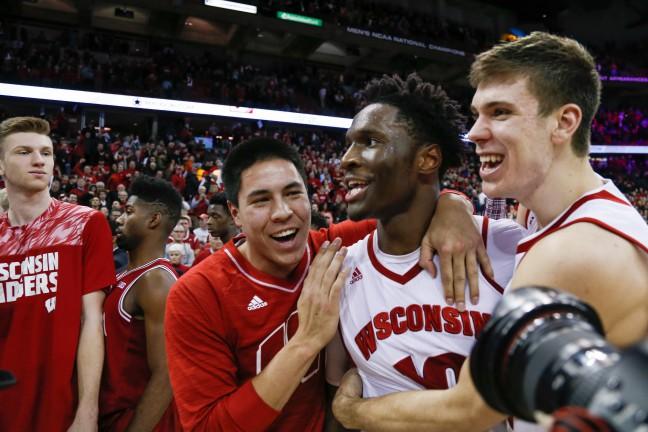From 1999-2017, the Wisconsin men’s basketball program had reached the NCAA tournament in 19 consecutive seasons, a streak that was upended last year during an injury-riddled season. Nevertheless, that near two-decade run placed Wisconsin in elite company — the Badgers were tied for the third-longest active tournament streak with fellow Big Ten powerhouse Michigan State and trailed only Duke and Kansas, two of the notorious “Blue Blood” programs.
The Blue Bloods’ decorated history and ability to guarantee success at the college level — paired with tremendous exposure, access and coaching (we’ll leave it at that) — leaves top-level recruits drooling at the opportunity to play for them.
Since the one-and-done era began in 2006, these few programs have seemingly held a tight monopoly on the pool of coveted five-star recruits. Duke, Kansas and others have dipped both feet deep in this pool and rank among the schools with the most freshman drafted in the NBA since 2006.
These players enjoy one successful college season and then depart for the NBA. The same programs then reel in next year’s best recruits, and the cycle repeats. The Blue Bloods have become a revolving door for one-and-done NBA talent.
So how do we make sense of Wisconsin’s success in all of this?
The Badgers have had just two five-star commits since 2000 — Brian Butch in 2003 and Sam Dekker in 2012 — yet they have been one of the NCAA’s winningest programs during that same span. When correlating recruiting with winning, the Badgers appear to be an anomaly.
But the answer is simple. Former Head Coach Bo Ryan and former assistant-turned-head Coach Greg Gard — and the rest of their coaching staffs — have done an exceptional job recruiting players who fit the Badger basketball mindset and culture. They have found the players who are coachable and the players who want to win at the college level and have developed them over a full college career.
Former Badger star Frank Kaminsky and current star Ethan Happ were both three-star recruits coming out of high school. Through their careers at Wisconsin, however, they each maximized their development and became among the nation’s top players, with Kaminsky being a unanimous men’s National College Player of the Year in 2015 and Happ possibly on his way to doing the same.
One cannot expect every three-star recruit to mimic the careers of Happ and Kaminsky, but these young men experienced tremendous success because they bought into the program.
It’s not that the Badgers do not want five-star, one-and-done level talent. Just because these recruits have been few and far between here, every coach, team and fan wants players with skills that can take him to the NBA right away. It’s been difficult for Wisconsin to compete with the track records that the Blue Bloods have had with one-and-dones. It’s every coach’s dream to recruit players who possess elite talent, who fit their ideology and who want to win at the college level. But coming across players who check all three boxes rarely happens.
When it comes down to it, most coaches will take the player who fits and who wants to win at the college level. This has been the recruiting recipe for Wisconsin basketball, and evidence over the past two decades suggests it’s worked.
Again, the Badgers would love to bring in one-and-done talent when it makes sense, but maybe it’s not the worst thing if its recruiting style continues in the future?
It’s the lack of one-and-done players that has helped shape the culture and camaraderie surrounding Wisconsin men’s basketball. With one-and-done players, Wisconsin would have never experienced that special group from 2013-14 that brought the Badgers to their first Final Four since 2000, and then come right back the next year and finish as the National Runner-Up (to Duke, nonetheless).
These back-to-back runs were led by tenured players like Kaminsky, Dekker, Duje Dukan, Josh Gasser, Traevon Jackson and Ben Brust — guys who were praised for their dedication to the program by not just die-hard Badger fans, but fans and critics from around the country. It is players like these with whom fans could form kinships and cheer for by name, a rarity in modern college basketball.
The programs who are constantly churning out NBA lottery picks miss out on the brotherhood that teams like Wisconsin’s back-to-back Final Four squad possess. Fans of those programs do not get to experience the relationships that Badger fans have formed with their players over the last two decades.
Those Badger teams in 2014 and 2015 were not without key contributions from young players such as Nigel Hayes, Zak Showalter, Bronson Koenig and Vitto Brown. This group of underclassmen had seen what their upperclassmen teammates had accomplished and were inspired to follow in their footsteps. So when the time came, they carried the torch and built their own legacy.
The Badgers have been fortunate to continue a run over the past two decades that strikes a winning balance between underclassmen and upperclassmen. The 2018-19 Badger squad is healthy and is following a beat reminiscent of those classic Bo Ryan-led teams from the past decade.
This unit features key contributions from veterans such as Happ, Khalil Iverson, Brevin Pritzl and D’Mitrik Trice, who have been building unique chemistry with each other on and off the court, as well as building a loyal following among fans. This team also features young guys like Nate Reuvers, Brad Davison, Kobe King and Aleem Ford, all of whom are making names for themselves and warming themselves to the Grateful Red.
We do not know what the future holds for this group of players or what kind of legacy they will leave, but what we do know by now is to trust the system instilled by this program.


